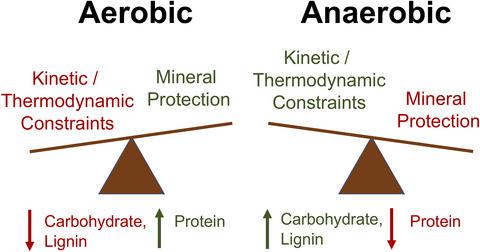当前位置:
X-MOL 学术
›
Glob. Change Biol.
›
论文详情
Our official English website, www.x-mol.net, welcomes your feedback! (Note: you will need to create a separate account there.)
Trade-offs in soil carbon protection mechanisms under aerobic and anaerobic conditions.
Global Change Biology ( IF 11.6 ) Pub Date : 2020-04-17 , DOI: 10.1111/gcb.15100 Wenjuan Huang 1 , Chenglong Ye 1, 2 , William C Hockaday 3 , Steven J Hall 1
Global Change Biology ( IF 11.6 ) Pub Date : 2020-04-17 , DOI: 10.1111/gcb.15100 Wenjuan Huang 1 , Chenglong Ye 1, 2 , William C Hockaday 3 , Steven J Hall 1
Affiliation

|
Oxygen (O2 ) limitation is generally understood to suppress oil carbon (C) decomposition and is a key mechanism impacting terrestrial C stocks under global change. Yet, O2 limitation may differentially impact kinetic or thermodynamic versus physicochemical C protection mechanisms, challenging our understanding of how soil C may respond to climate-mediated changes in O2 dynamics. Although O2 limitation may suppress decomposition of new litter C inputs, release of physicochemically protected C due to iron (Fe) reduction could potentially sustain soil C losses. To test this trade-off, we incubated two disparate upland soils that experience periodic O2 limitation-a tropical rainforest Oxisol and a temperate cropland Mollisol-with added litter under either aerobic (control) or anaerobic conditions for 1 year. Anoxia suppressed total C loss by 27% in the Oxisol and by 41% in the Mollisol relative to the control, mainly due to the decrease in litter-C decomposition. However, anoxia sustained or even increased decomposition of native soil-C (11.0% vs. 12.4% in the control for the Oxisol and 12.5% vs. 5.3% in the control for the Mollisol, in terms of initial soil C mass), and it stimulated losses of metal- or mineral-associated C. Solid-state 13 C nuclear magnetic resonance spectroscopy demonstrated that anaerobic conditions decreased protein-derived C but increased lignin- and carbohydrate-C relative to the control. Our results indicate a trade-off between physicochemical and kinetic/thermodynamic C protection mechanisms under anaerobic conditions, whereby decreased decomposition of litter C was compensated by more extensive loss of mineral-associated soil C in both soils. This challenges the common assumption that anoxia inherently protects soil C and illustrates the vulnerability of mineral-associated C under anaerobic events characteristic of a warmer and wetter future climate.
中文翻译:

有氧和厌氧条件下土壤碳保护机制的权衡。
氧气(O2)的限制通常被理解为抑制石油碳(C)的分解,并且是在全球变化下影响陆地C储量的关键机制。然而,O 2的限制可能会影响动力学或热力学与物理化学C保护机制的差异,这挑战了我们对土壤C可能如何响应气候介导的O 2动态变化的理解的挑战。尽管O2的限制可能会抑制新的凋落物C输入的分解,但是由于铁(Fe)的还原而释放出具有物理化学保护作用的C可能会维持土壤C的损失。为了测试这种折衷,我们在有氧(对照)或厌氧条件下,将两种经历周期性O2限制的不同高地土壤(一种热带雨林Oxisol和一个温带农田Mollisol)加了垫料孵育了1年。相对于对照,缺氧抑制了Oxisol的总C损失27%和Mollisol的41%,这主要是由于凋落物C分解的减少。但是,缺氧持续或什至增加了天然土壤C的分解(就初始土壤C质量而言,Oxisol为11.0%,对照为Moxsol的12.4%,而Mollisol为5.3%),并且它刺激了金属或矿物相关C的损失。固态13 C核磁共振波谱表明,厌氧条件相对于对照降低了蛋白质衍生的C,但增加了木质素和碳水化合物C。我们的结果表明,在厌氧条件下,物理化学保护和动力学/热力学C保护机制之间需要权衡取舍,因此,两种土壤中与矿物相关的土壤C的大量流失弥补了凋落物C分解的减少。这挑战了缺氧固有地保护土壤C的普遍假设,并说明了在未来气候变暖和潮湿的厌氧事件下矿物相关C的脆弱性。
更新日期:2020-03-30
中文翻译:

有氧和厌氧条件下土壤碳保护机制的权衡。
氧气(O2)的限制通常被理解为抑制石油碳(C)的分解,并且是在全球变化下影响陆地C储量的关键机制。然而,O 2的限制可能会影响动力学或热力学与物理化学C保护机制的差异,这挑战了我们对土壤C可能如何响应气候介导的O 2动态变化的理解的挑战。尽管O2的限制可能会抑制新的凋落物C输入的分解,但是由于铁(Fe)的还原而释放出具有物理化学保护作用的C可能会维持土壤C的损失。为了测试这种折衷,我们在有氧(对照)或厌氧条件下,将两种经历周期性O2限制的不同高地土壤(一种热带雨林Oxisol和一个温带农田Mollisol)加了垫料孵育了1年。相对于对照,缺氧抑制了Oxisol的总C损失27%和Mollisol的41%,这主要是由于凋落物C分解的减少。但是,缺氧持续或什至增加了天然土壤C的分解(就初始土壤C质量而言,Oxisol为11.0%,对照为Moxsol的12.4%,而Mollisol为5.3%),并且它刺激了金属或矿物相关C的损失。固态13 C核磁共振波谱表明,厌氧条件相对于对照降低了蛋白质衍生的C,但增加了木质素和碳水化合物C。我们的结果表明,在厌氧条件下,物理化学保护和动力学/热力学C保护机制之间需要权衡取舍,因此,两种土壤中与矿物相关的土壤C的大量流失弥补了凋落物C分解的减少。这挑战了缺氧固有地保护土壤C的普遍假设,并说明了在未来气候变暖和潮湿的厌氧事件下矿物相关C的脆弱性。


























 京公网安备 11010802027423号
京公网安备 11010802027423号